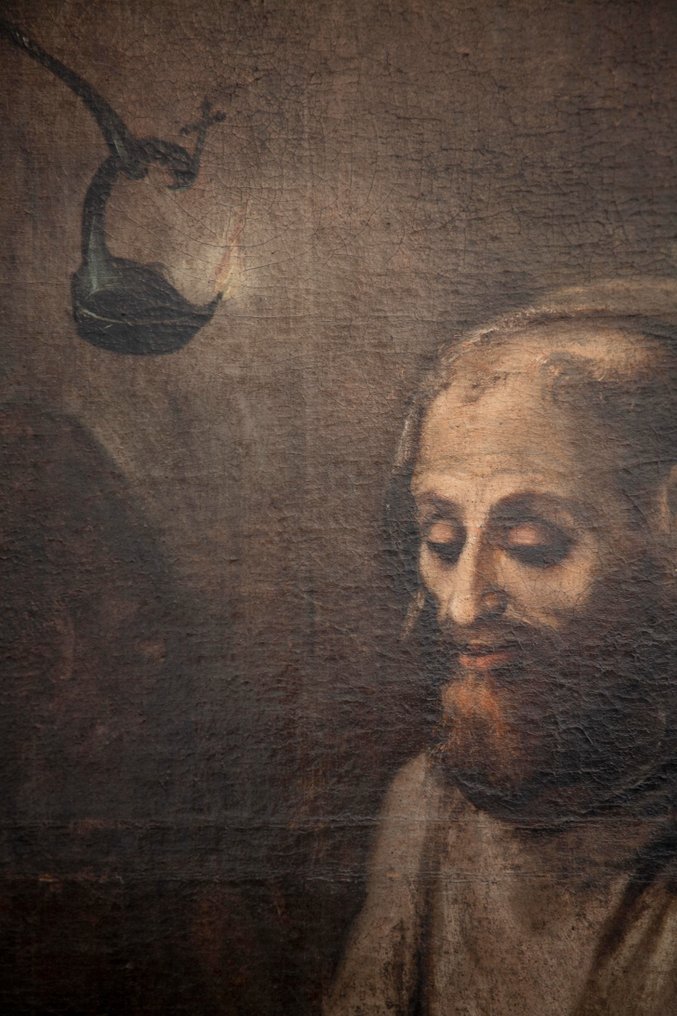
Escuela sevillana (XVIII) - San Antonio con Niño
Catawiki aggiorna costantemente la tecnologia in uso sulla sua piattaforma. Al momento stai utilizzando un browser obsoleto. Per ottimizzare la tua esperienza di navigazione, ti consigliamo di aggiornare il tuo browser.
Puoi impostare le tue preferenze sulla gestione dei cookie selezionando le opzioni qui di seguito. Puoi aggiornare le tue preferenze, ritirare il tuo consenso in qualunque momento e consultare una descrizione dettagliata dei tipi di cookie utilizzati da noi e dai nostri partner nella nostra Informativa sui Cookie.
N. 85538929



Painting has 19th century relining.
Comes with charming 17th century frame (some faults caused by xylophages), measures 142 x 124 cm.
Although the motif is humble the appearance is majestic because of the size of the painting.
Giovanni di Pietro di Bernardone (c. 1181 – 3 October 1226), known as Francis of Assisi, was an Italian mystic, poet, and Catholic friar who founded the religious order of the Franciscans. Inspired to lead a Christian life of poverty, he became a beggar and itinerant preacher.
The Franciscan Order promoted devotion to the life of Francis from his canonization (1228) onwards, and Francis appeared in European art soon after his death. The order commissioned many works for Franciscan churches, either showing him with sacred figures or episodes from his life. There are countless seventeenth- and eighteenth-century depictions of Saint Francis of Assisi, mostly in Italy and Spain.
Painted motif praying St Francis referres to his time on the mountain of Verna, during a forty-day fast in preparation for Michaelmas (29 September), where he is said to have had a vision on or about 13 September 1224, the Feast of the Exaltation of the Cross, as a result of which he received the stigmata.
Oil lamp on the painting has a significance in Catholic church: “In accordance with traditional custom, near the tabernacle a special lamp, fueled by oil or wax, should be kept alight to indicate and honor the presence of Christ." On the 4th of October, St Francis of Assisi Memorial Day in the town of Assisi, citizens light oil lamps, with an oil that has been blessed by a Priest.
Painting has 19th century relining.
Comes with charming 17th century frame (some faults caused by xylophages), measures 142 x 124 cm.
Although the motif is humble the appearance is majestic because of the size of the painting.
Giovanni di Pietro di Bernardone (c. 1181 – 3 October 1226), known as Francis of Assisi, was an Italian mystic, poet, and Catholic friar who founded the religious order of the Franciscans. Inspired to lead a Christian life of poverty, he became a beggar and itinerant preacher.
The Franciscan Order promoted devotion to the life of Francis from his canonization (1228) onwards, and Francis appeared in European art soon after his death. The order commissioned many works for Franciscan churches, either showing him with sacred figures or episodes from his life. There are countless seventeenth- and eighteenth-century depictions of Saint Francis of Assisi, mostly in Italy and Spain.
Painted motif praying St Francis referres to his time on the mountain of Verna, during a forty-day fast in preparation for Michaelmas (29 September), where he is said to have had a vision on or about 13 September 1224, the Feast of the Exaltation of the Cross, as a result of which he received the stigmata.
Oil lamp on the painting has a significance in Catholic church: “In accordance with traditional custom, near the tabernacle a special lamp, fueled by oil or wax, should be kept alight to indicate and honor the presence of Christ." On the 4th of October, St Francis of Assisi Memorial Day in the town of Assisi, citizens light oil lamps, with an oil that has been blessed by a Priest.








